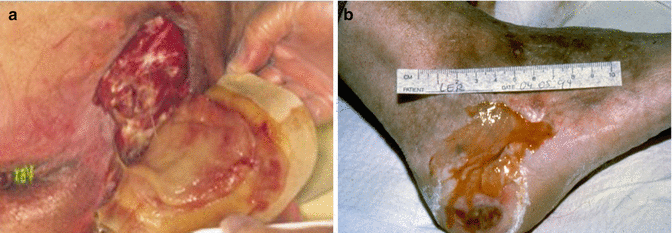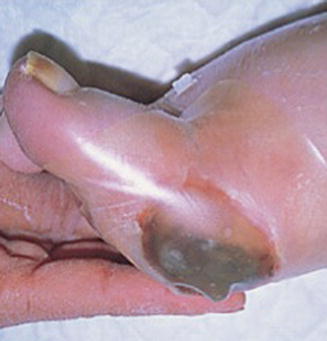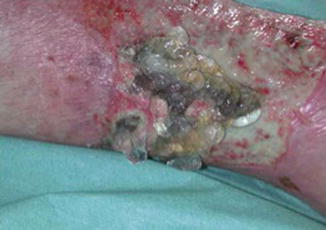Fig. 41.1
(a) Appearance of hydrogel applied on necrotic tissue two days ago. (b) During application, the gels sticks to the wound, and the porduct layer should not be applied on the wound edges
41.2.1.2 Hydrogel-Like Devices
Over the last few years, the classic formulations of hydrogels have changed. Adding antiseptics was proposed, and of the products currently on the market, the following could be mentioned:
A matrix of hydroxyethyl cellulose polymers, insoluble and hydrophilic, containing 85 % water and octenidine dichlorhydrate, a cationic antibacterial belonging to the bipyridine family [5];
A solution containing hydrogel, but also polyhexamethylene biguanide (PHMB) together with betaine. PHMB is an antimicrobial belonging to the biguanide family, whose property is to reduce the bacterial load by acting on the phospholipids of the bacterial membrane. Betaine is a tensioactive agent called a surfactant, whose action is to dissolve fibrinous material on the wound surface [6].
One of the main expected actions of these devices is to eliminate and prevent biofilm formation.
41.2.2 Mixed “Hydrating/Absorbent” Dressings
41.2.2.1 Irrigo-Absorbents
Irrigo-absorbent dressings are gaining popularity among debridement dressings, although only one device has been launched under TenderWet [7]. It is a multilayer dressing presenting a shape of a cushion whose centre is mainly composed of polyacrylate particles activated by an adequate volume of Ringer solution. The superabsorbent polyacrylate presents an increased attraction for wound exudate rich in proteins compared with the Ringer solution. The combined action of irrigation is due to the continuous delivery of Ringer and the drainage of exudates. Periwound blanching may be observed when the dressing lies over the wound edges; a water paste or zinc oxide paste can be proposed. The Cleansite study article now in press demonstrates the superiority of the product over normal hydrogel in long-term undebrided chronic leg ulcer.
41.2.2.2 Hydrocolloids
Considered to be active at all wound healing stages, hydrocolloids occupy a relatively modest position in the list of debriding agents. These older devices have been progressively supplanted by more adaptive dressings. Composed mostly of sodium CMC, they jellify when in contact with fibrin or necrosis and provide an optimal level of moisture (Fig. 41.2a). The absorption of exudate occurs slowly and moderately and their use is indicated in the presence of humid necrosis and mainly for superficial wounds owing to the speed of action.


Fig. 41.2
(a) Aspect of hydrocolloid after two days. Gelification smells and look like pus. (b) Hydrocolloid dressing should ideally be placed 3 cm over the wound edges
They can be found as fairly thick sheets, opaque or transparent and with anatomical shapes (sacrum, heel, elbow). All are adhesive and do not require secondary dressings. The dressing should lie at least 3 cm over the edges of the wound to obtain maximal adhesion (Fig. 41.2b). In some cases, an adhesive tape can be used to secure the edges of the dressing in place.
41.2.3 Absorbent Dressings
Absorbent dressings are composed of various materials such as alginate, CMC and polyacrylate. Their main characteristic is that they jellify when in contact with exudates without being destroyed. To be active during the debridement stage, the dressing should not dry out between two successive changes. They are available as gauzes or meshes.
41.2.3.1 Alginates
Alginates are polymers of alginic acid obtained from brown algae. They are differentiated from each other by their chemical composition and thus their physical properties. When guluronic acid is predominant compared with mannuronic acid, the dressing will be more rigid. Ca++ and Na+ concentrations and the presence or absence of CMC provide different levels of absorption. The jellification of alginate fibres is concomitant with the formation of Na alginate, which is soluble in water and highly hydrophilic, and/or with the presence of CMC (Fig. 41.3).


Fig. 41.3
Highly exudating wound covered with an alginate will be changed when saturated
Maintaining the adapted level of moisture without occlusiveness allows better efficacy. Their haemostatic capacity is also an interesting property [8]. In order to facilitate the removal of the dressing, NaCl 0.9 % may be used (Fig. 41.4). Alginates are contraindicated over dry wounds or during the epidermisation stage. Sequential use of alginates during the debridement stage is recommended by numerous guidelines [9].










